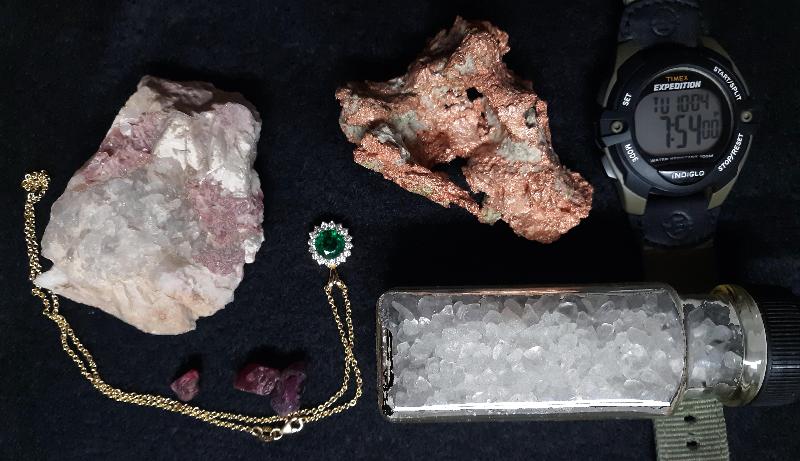
Earth Science Extras
by Russ Colson

Emerald, ruby, native copper, lithium ore, halite, and a quartz watch--some of the uses of minerals.
The exercises in this lesson are sort of "mineral scavenger hunts" in the sense that you are going to 'hunt' for the minerals online that meet certain criteria. This is mainly a way to learn about some minerals and their uses and so involves less 'conceptual understanding' than many of my lessons. It is, however, a way to become familiar with some of the natural mineral resources on which our economy depends and what geological minerals those materials come from. I recommend that you have fun looking up mineral info online!
Just a note, when you search for 'minerals' online, you won't get information only about geological minerals (that is, naturally occuring materials with a definite composition and a crystal structure), but will also get information about dietary minerals (as in "vitamans and minerals") and resource minerals (like iron, gold, rare earth elements and so on). Don't get those different meanings of the word "mineral" mixed up!
Another note: The three problems below are giantmatching problems. You need to figure everything out, researching online and taking notes, maybe taking 15-30 minutes, before answering!
What are the geological minerals that serve as primary ores for resource minerals like Fe, Cr, Mn, etc?
Have you ever wondered why people learned to use some minerals and materials sooner than others? For example, why was there a copper age, a bronze age, an iron age, and then, over 2000 years later, an "aluminum" age? Why did we use some metals before others?
You might think that we just 'discovered' some metals earlier, or they were more accessible to early people, or the ores were just more noticeable (possibly the case for copper ore which is very noticeable!) However, a more interesting possiblity emerges when we consider how hard it is to separate each metal from the other elements of the earth to which it is naturally bonded.
One measure of how much energy it takes to separate a metal from the other elements to which it is bonded is Gibbs Free Energy of formation from the elements. This is the amount of energy that is released when we allow the elements to react with each other to form mineral compounds. That same amount of energy has to be pumped back in to the system if we are to separate the elements from each other. That is, lower energy for formation from the elements (greater negative energy) corresponds to more energy being required to separate a metal from the other elements to which it is bonded. Interestingly, the order in which we learned to smelt the different metals is roughly in order of increasing energy to separate a metal from other elements.
For the most part, we have to measure the Gibbs Free Energy of formation in the laboratory (actually, we have to measure changes among measurable variables such as volume, pressure, temperature, and heat from which Gibbs Free Energy can be calculated). However, we can make estimates for the energy of strongly ionic minerals by considering the energy of the electrostatic attraction of the ionic bonds between cations and anions. This becomes a problem of physics, calculating the energy of the attraction between oppositely charged bodies.
Energy = (AZ+Z-/d)
Where Z = charge on the cation (+) and anion (-), d = interatomic distance, and A is the Madelung constant which depends on crystal structure. Because of the negative charge of the anion, the value of the energy will always be negative, with the more stable (lower energy) minerals having a larger negative energy.
From this expression we can see that crystals with ions that are closer together will have a lower energy (larger negative energy), as will crystals with ions of higher charge. The ions in crystals with lower energy (that is, larger negative energy) will be harder to 'separate' because more energy has to be pumped into the system to break the bonds. This will mean, for example, that it is harder to melt the crystals with lower energy because the temperature must be raised higher to overcome the energy of the bond.
Note: For the problem below, you need to first calculate (or at least estimate) the relative value of the energy for each of the cation-anion pairs (assuming that the Madelung constant stays constant, although, in fact, it does not stay quite the same because these materials have somewhat different crystal structures). Take time to do these calculations and then figure out through logical reasoning which energy goes with which pair--don't just guess!
last updated 10/5/2022. Text and pictures are the property of Russ Colson.